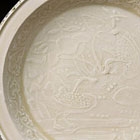J.J. Lally & Co., Oriental Art / New York City, New York
MenuPast Exhibition
Chinese Ceramics in Black and White
March 20–April 10, 2010
19.
A MOULDED DINGYAO WHITE PORCELAIN
‘DUCKS-IN-LOTUS-POND’ DISH
Song Dynasty (A.D. 960–1279)
following a silver shape, the wide flat center of the dish decorated with a scene of two mandarin ducks, one standing on the shore and the other swimming in a pond with blossoming lotus, the narrow rounded sides with a continuous frieze of floral scroll below the flat everted rim, covered with a transparent glaze of pale ivory tone continuing over the angled foot and shallow countersunk base, the upturned lip of the rim left unglazed showing the fine white porcelain.
Diameter 55⁄8 inches (14.3 cm)
The design on this dish is a rebus for an auspicious wish: yuanyang guizi (May you enjoy a happy marriage and have many illustrious sons), because yuanyang (mandarin ducks) mate for life, and so became symbolic of a happy marriage, and lotus flowers bloom with the seedpod already in place, and so became symbolic of the early arrival of sons.
A very similar Dingyao dish moulded with this pattern, from the collection of Edward T. Chow, is illustrated by Wirgin in “Sung Ceramic Designs,” B.M.F.E.A., Bulletin no. 42, Stockholm, 1970, pl. 97b. Another example, from the Collection of Helen Nichols Cabot in the Museum of Fine Arts, Boston, is illustrated by Fontein and Wu in The World’s Great Collections: Oriental Ceramics, Vol. 10, Museum of Fine Arts, Boston, Tokyo, 1980, col. pl. 17, discussed on p. 160, and another very similar Dingyao dish from the Collection of Lucy Maud Buckingham in the Art Institute of Chicago is illustrated by Pearlstein et. al. Asian Art in the Art Institute of Chicago, Chicago, 1993, p. 59.
宋 定窰白瓷印花鴛鴦貴子盤 徑 14.3 厘米
